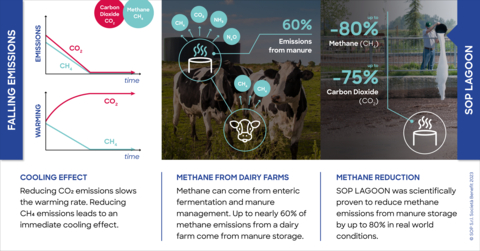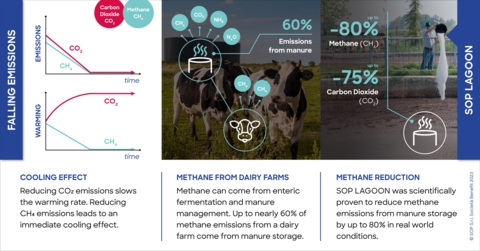PARK CITY, Utah--(BUSINESS WIRE)--Resonant Technology Group (“Resonant”) is excited to announce profound scientific results from their product, SOP® Lagoon, which provides unrivaled GHG emission reductions and sustainability benefits to the beef and dairy industries. Joint research from the University of Milan and UC Davis resulted in a published paper in the peer reviewed journal Sustainability reporting significant reductions of Greenhouse Gases (GHGs) from dairy lagoons – 80% less methane (CH4) and 75% less carbon dioxide (CO2) — within weeks of the first use of Resonant’s SOP® Lagoon product.
The extensive, 3.5-month in-field real scale study performed at a commercial 520-head dairy in Northern Italy found an 80% reduction in effluent methane release — the most significant of any available solution. The results show that Resonant’s solution is the only additive that so successfully mitigates lagoon dairy waste releases that are responsible for up to 57% of total dairy methane emissions. This study shows an improvement over the results obtained by the other peer reviewed scientific works from the two separate teams at the University of Milan (Prof. Guarino) and UC Davis (Prof. Mitloehner) confirming that SOP® Lagoon presents an immediate, actionable and meaningful solution to reduce the carbon footprint of the dairy and cattle industries.
SOP® Lagoon was developed by the Italian firm Save Our Planet (“SOP”) and is marketed by Resonant. The product is based on a proprietary, trade secret-protected science that has been used by thousands of farmers across SOP® Inside products for animals, crops, soils and vineyards for 20 years in Europe and North America. SOP® Lagoon is a mineral 0.07 oz (2g) / head additive that is deployed once a week into the lagoon and can be used in addition to a suite of products that have been shown in scientific works to additionally reduce enteric and soil emissions. Application of the product is simple and requires no specialized expertise. The University of Milan paper is the most recent of five (5) studies supporting the efficacy of Resonant’s SOP® Inside products, including a study at UC Davis, again by Prof. Frank Mitloehner’s lab, supporting SOP® Star Cow’s potential to reduce enteric emissions.1 The combined lagoon, enteric and soil emission reduction potential is greater than 50% of total GHG emissions from diary operations — a level of overall reductions significantly greater than any other known solution and without any known side effects.
SOP® Lagoon in Numbers
The University of Milan study concludes that SOP® Lagoon can significantly reduce the methane and other emissions.
To put these reductions into perspective:
- A 250 head dairy farm would require 3.7 ounces of product per head per year, or a total of 57 pounds per year at a current yearly retail cost of less than $2,000.
- The reduced methane emissions resulting from this application would equal more than 1,000 tons of CO2 equivalent.
- The larger-scale potential impact of adoption of SOP® Lagoon by the dairy industry is profound: if 1 million cows (approximately 10% of the North America dairy herd) were to adopt the product, the reduced methane emissions would equal more than 4 million tons of CO2 equivalent.
SOP® Lagoon: Real actionable results environmentally, economically & neighborly
The vast majority of solutions targeting methane and other GHG emissions from dairy and cattle operations focus on reducing enteric and manure emissions that make up roughly 40% of the total emissions from dairy operations. But there are few solutions in the market today that can address, on a practical and cost-effective basis, emissions emanating from the effluents flowing from dairy barns — effluents and manure that account for up to 60% of methane emissions from a typical dairy operation.
As the regulatory and voluntary Carbon Credit markets continue to mature, SOP® Lagoon’s product — with proven field test results, no legacy base line issues and the potential to contract long-term conditioned only on the continued use of the product — could become one of the most compelling products underlying livestock methane credits at a value that more than pays for its use.
Pricing for carbon credits and offsets on voluntary and compliance markets varies widely also based on type of project, location, standard of certification and market dynamics. For example, according to the 8 Billion Trees Carbon Credit Pricing Matrix, the potential value of methane based voluntary carbon credits for the example 250-head herd above could range from $4,000 to over $20,000 per year equal to 2-10x the cost of SOP® Lagoon. The potential value of such offsets on the compliance market would range materially higher.
SOP® Lagoon’s dramatic (up to 100%) reduction of ammonia (NH3) referenced in prior studies may be one of its most compelling attributes as this gas impacts animal wellbeing and productivity as well as human health. Scientists and policy makers are focusing on the detrimental impacts of ammonia release and are considering adding the gas to the target list of GHGs.
Finally, like its predecessor studies, the University of Milan study cited persistent observations by farmers and researchers alike that the SOP® Lagoon product dramatically reduced or eliminated the noxious odors flowing from dairy operations within weeks of its application. As an example, one large US dairy operation, Tillamook County Creamery Association, has used SOP® Lagoon to such end and reports it being successful in odor mitigation.
Conclusion
Methane is a powerful climate pollutant that accounts for about half of the net rise in global average temperature since the pre-industrial era. Methane is one of the three most important GHGs (with CO2 and nitrous oxide) and is around 85 times more potent than carbon dioxide, but it remains in the atmosphere for a much shorter time (10-12 years vs 100 for CO2). Consequently, reducing methane emissions offers the fastest way to slow global warming.
This is why in late 2021 the US and EU unveiled a Global Methane Pledge that seeks 30% reductions from 2020 levels of human-caused methane releases by 2030. If successful, this could achieve approximately 145 million tons in annual reductions, equivalent to a 35% reduction compared to the expected levels within the same time frame, consistent with limiting the global warming to below 1.5°C and preventing over 0.2°C of extra warming by 2050.
To put that in context, dairy cows alone are responsible for 8% of global methane pollution. Large dairy corporations agree that the vast majority — ~80% — of the total carbon footprint in a gallon of milk emanates from Scope 3 emissions generated at the farm level and only ~20% is attributable to the processing and distribution of milk.
Resonant’s SOP® Lagoon product has the potential to massively improve the dairy industry’s footprint and its alignment to sustainability policies (including ESG and UN SDGs) in a practical, economic and scalable way, today.
About SOP
SOP stands for Save Our Planet. Founded in 2001, SOP is a technology company headquartered in Milan, Italy. SOP is led by founder Marco Poggianella and is made up of engineers, chemists, agronomists, animal nutritionists, biologists and veterinarians that continue to validate and improve the implementation of SOP's proprietary technology for application to crops, animals, soils and vineyards. SOP has obtained an “AAA” ESG rating with a certified alignment to all the 17 SDGs.
About Resonant Technology
Resonant Technology Group, a US company, is an affiliate of SOP. Resonant distributes SOP® Inside products that provide solutions that extend far beyond the farm. Resonant is developing new and innovative ways of applying SOP® Inside technology with the aim of promoting GHG mitigation while enabling adaptation of agriculture, food industries and entire supply chains.
1 Uni Milan on Liquid Manure in small scale, Sustainability, 2019
UC Davis on Liquid Manure in small scale , Sustainability, 2020
UC Davis on enteric emissions, Sustainability, 2020
Università Cattolica on corn cultivation, Agronomy, 2021
Uni Milan on Liquid Manure in real scale, Sustainability, 2023




